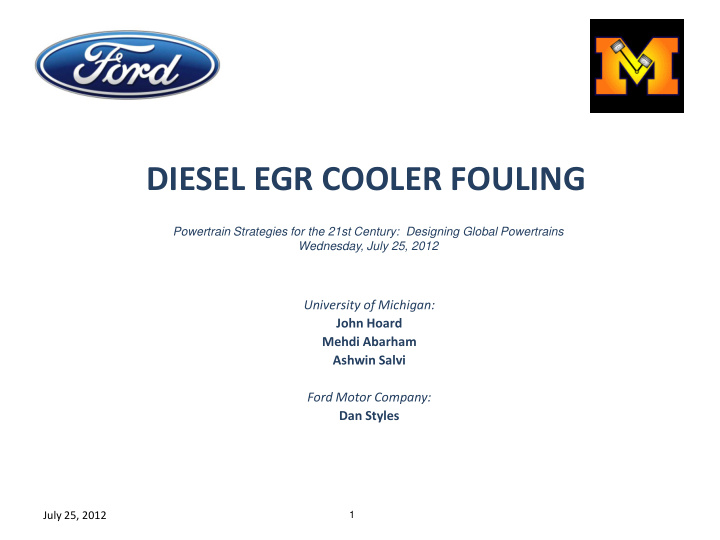



DIESEL EGR COOLER FOULING Powertrain Strategies for the 21st Century: Designing Global Powertrains Wednesday, July 25, 2012 University of Michigan: John Hoard Mehdi Abarham Ashwin Salvi Ford Motor Company: Dan Styles July 25, 2012 1
Background Modern diesels use cooled EGR • – Reduced engine out NOx emissions – May reduce particulate emissions • Cooled surfaces foul – Soot - thermophoresis – HC, water, acids – condensation • Processes have been modeled – Abarham et.al. • Uncertainties remain – Removal mechanisms – In-situ morphology – Thermal properties of layers • So, we built a visualization rig – Describe rig and show example test 2
Deposit Characteristics 3
Thermophoresis is the Dominant Mechanism • Scaling analysis of deposition mechanisms for a selected common boundary condition From Abarham PhD thesis 4
Scaling Analysis of Acting Forces • Scaling analysis of forces acting on an attached particle to wall – Drag – Lift – Weight – Van der Waals – Updraft force • Van der Waals is strong enough to keep the particles attached • It seems unlikely that particles are re- entrained by drag force or turbulent bursts at common EGR flow rates From Abarham PhD thesis 5
CFD Models-Experiments Comparisons Deposited soot mass gain Effectiveness drop model results vs. experimental measurements model results vs. experimental measurements 3 hours exposure time 3 hours exposure time • Better estimation on mass deposited by the axi-symmetric model • Overall, closer estimation of heat transfer reduction by the axi-symmetric model 6
Model Results for Longer Term Exposures Filtered Exhaust Exhaust 7 Cooler effectiveness comparison Tube effectiveness comparison long time exposure longer time exposure For longer term experiments a soot removal mechanism is required to • achieve correlation • However, carefully constructed experiments to quantify the removal experiment did not yield the expected results. Further work required…. 7 7
EGR Cooler Visualization Test Rig John Hoard, Mehdi Abarham, Tejas Chafekar Dennis Assanis, Dan Styles, “A Visualization Test Setup for Investigation of Water-Deposit Interaction in a Surrogate Rectangular Cooler Exposed to Diesel Exhaust Flow “, SAE paper 2012-01-0364, April 2012 8
Test Stand Photo Exhaust In Air In 9
Imaging Ability 10
Surface Image During Deposition Large Particles Initial clean After two hours 50X magnification – brightness and contrast adjusted Note large particles 11
Particle Sampling • Normal diesel nanoparticles follow flows – Not likely to impact inertially – Thus, easy to sample • Large particles (tens of microns) – 100X diameter, 10,000X area, 1,000,000X mass! – Separate inertially – Ideally need isokinetic sample – We used simple sample – Likely to miss many particles 12
Magnified Image 200x magnification, imaging area 1.72mm by 1.29 mm. 13
Particle Number versus Threshold T = 0.26 T = 0.29 14
Engine-Out Sample Max = 90 particles Multiple images processed and averaged 15
Typical Published Particle Size Distribution Harris, S.J., Maricq, M.M., “The Role of Fragmentation in Defining the Signature Size Distribution of Diesel Soot”, J. Aerosol Science 33 : 935-942, 2002. 16
Coolant 9°C, Start Air then Exhaust Flow Actual size 6.88x5.16mm 50X magnification Each second in the March 22 test movie is 4 minutes in real time. 17
Conclusions • EGR Cooling fouling is a surprisingly rich research area • Soot deposits due to thermophoresis - ~90% of deposit mass Heavy HC (C 12 +) condense • • Acidic water condenses • Removal mechanism is required but not understood • Heat transfer properties of deposits in-situ not known • Visualization rig to investigate – Large particles – Water condensation removal – Experiments continue 18
Acknowledgments • This work was done at the University of Michigan’s Walter E. Lay Automotive Laboratory under sponsorship of Ford Motor Company Research and Advanced Engineering. • Thanks to Ashwin Salvi for help in running the engine and test cell. 19
Questions? 20

Recommend
More recommend